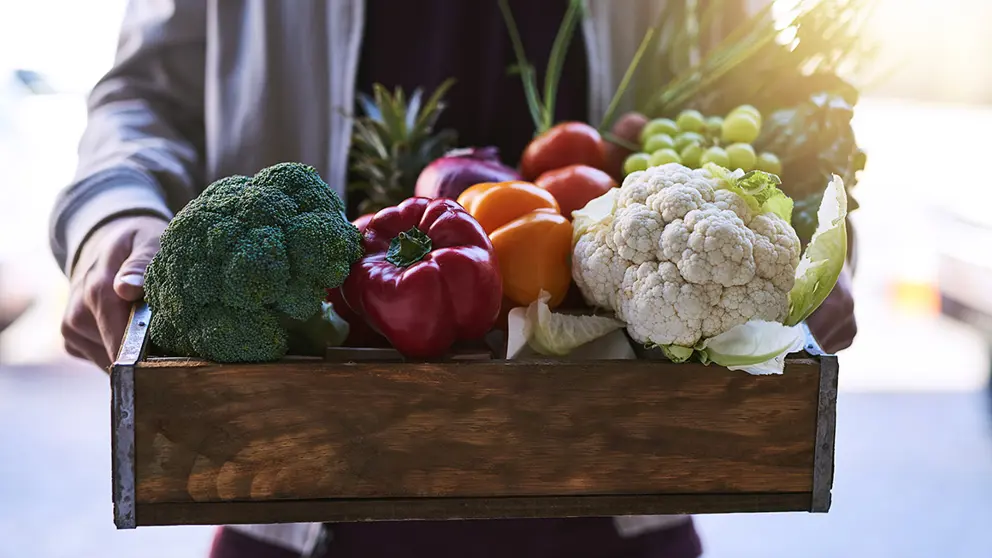The new version of Canada’s Food Guide encourages us to eat more plant-based foods, but not to the exclusion of animal-based foods. The idea is to choose protein foods that come from plants more often, because they provide more fibre and less saturated fat than animal-based proteins. This change is intended to help support your heart health.
The Eat Well Plate, the leading graphic of the Food Guide, makes it easy to choose plant-based meals by its design. You simply fill half your plate with vegetables and fruit (plants!), ¼ plate with whole grains (plants!) and the remaining ¼ plate with protein-rich foods (plants or animal-based foods).
The Food Guide takes a flexible approach – it’s not advocating for 100% vegan diets, but is simply making Canadians aware of the health benefits of eating more foods like chickpeas, lentils, tofu and peanut butter. Think of plant-based as the term for choosing plant-based meals often, but not to the exclusion of the occasional juicy steak.
I’ve long said that there’s no one right diet for everyone, and the best eating plan is one you can stick to in the long term. The beauty of plant-based eating is that it’s not restrictive, so it’s easier to stick to. It’s not really a diet, but more of a lifestyle.
What are the benefits of plant-based foods?
Including more vegetables, whole grains, beans, nuts and seeds (plant-based foods) is so good for you! Some of the benefits include:
- Disease reduction: The winning combination of vegetables, beans, whole grains, nuts and seeds helps reduce blood pressure and cholesterol levels, and reduces your risk of developing type 2 diabetes, Alzheimer’s disease, heart disease and some types of cancer. It’s likely due to the synergistic combination of vitamins, minerals, antioxidants and fibre found in plant-based foods.
- Healthy fibre: Plant-based foods are high in fibre, while animal foods contain no fibre. Most Canadians fall short of this nutrient, and that deficit contributes to high cholesterol and blood sugar levels, digestive disorders and other conditions. Eating more vegetables, seeds and beans can up your fibre intake.
- Help for the environment: Studies show that plant-based foods have a smaller impact on the environment because growing these foods uses less water and creates fewer emissions than animal-based foods, The good news is that many Canadian farmers – whether they farm cows, chickens, soybeans, wheat or fruit – are taking measures to protect the environment, so this issue is important to everyone and improvements are happening in many places.
- Savings: The most expensive items in your grocery cart are often meat, poultry and fish. Give your wallet a break by choosing plant-based protein sources such as lentils, beans, split peas, tofu, peanut butter and sunflower or pumpkin seeds.
It’s important to remember that the plant-based foods recommended in the Food Guide are whole, relatively unprocessed options. Switching to ultra-processed plant- based foods, such as veggie dogs; processed burgers and sausages; mock chicken nuggets; salty corn or potato chips; or lots of sweets made from sugar and refined flour (both were once plants!) is not the intent here.
Remember, you don’t have to give up meat, fish and dairy entirely to reap the benefits of eating plant-based meals more often. In fact, some of the healthiest eating plans - like the DASH and Mediterranean diets - are mostly plant-based, but include small amounts of fish, milk and poultry, which are beneficial to overall health. (The omega-3 fats in fish are great for heart health!)
So, start small. Maybe switch to plant based meals once a week. Once you get used to that, try twice a week, and so on. You can also transition slowly by tweaking recipes. For example, maybe you can make your usual beef chili with half-beef and half-beans. Or prepare lentil tacos, but top them with shredded cheddar. It’s up to you! The key is to get more plants into your diet, so even baby-steps can make a difference.
If you’re not sure where to start, consider any of these swaps:
Breakfast
Instead of… animal-based
-Oatmeal, milk, banana
-Cheese on toast
Try… plant-based
-Oatmeal, soy milk, banana
-Peanut butter on toast
Lunch
Instead of… animal-based
-Chicken Caesar salad
-Tuna sandwich
Try… plant-based
-Chickpea Caesar salad
-Hummus & veggie sandwich
Dinner
Instead of… animal-based
-Beef tacos with tomato, lettuce and sour cream
-Turkey chili with brown rice
Try… plant-based
-Lentil tacos with tomato, lettuce and guacamole
-Bean chili with brown rice
Try our Tofu stir-fry, Curried lentils and vegetables and Broccoli lentil pasta and find more plant-based recipes at heartandstroke.ca/recipes.
Learn more about healthy eating to reduce your risk of heart disease and stroke.
